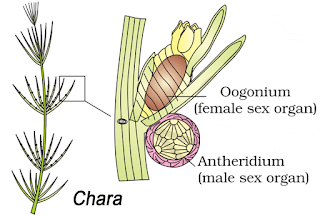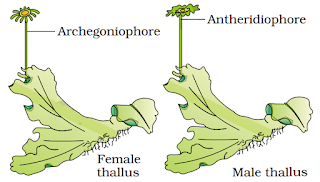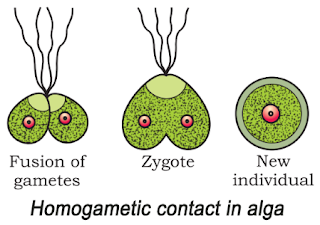Reproduction in Organism : Notes and Study Materials -pdf
Notes and Study Materials
- Concepts of Reproduction in organisms
- Master File Reproduction in organisms
- NCERT Book chapter Reproduction in organisms
- NCERT Solutions for – Reproduction in organisms
- NCERT Exemplar Solutions for – Reproduction in organisms
- Revision Note of Reproduction in organisms
- Past Many Years Question papers and Answer of Reproduction in organisms
- Mind Map of Reproduction in organisms
Examples and Exercise
1. REPRODUCTION IN ORGANISMS
- Reproduction is a process in which an organism produces young ones (offspring) similar to itself.
- The period from birth to the natural death of an organism is known as its lifespan.
- No individual is immortal, except unicellular organisms. There is no natural death in unicellular organisms
Life spans of some organisms | Organism | Lifespan | Organism | Lifespan | Organism | Lifespan |
Rose | 5-7 years | Butterfly | 1-2 weeks | Tortoise | 100-150 yrs | |
Rice plant | 3-7 months | Fruit fly | 2 weeks | Crow | 15 yrs | |
Banyan tree | 400+ yrs | Parrot | 140 yrs | Cow | 22 yrs | |
Banana tree | 2-3 yrs | Crocodile | 60 yrs | Elephant | 50-70 yrs | |
Dog | 22 yrs | Horse | 40-50 yrs |
- Based on the number of participants, reproduction is 2 types: Asexual reproduction & Sexual reproduction.
- It is the production of offspring by a single parent.
- It is seen in unicellular organisms, simple plants & animals.
- The offspring are identical to one another and to their parent. Such morphologically and genetically similar individuals are known as clone.
- Binary fission: It is the division of parent cell into two individuals. E.g., Amoeba, Paramecium.
- Multiple fission: It is the division of parent cell into many individuals. E.g. Plasmodium, Amoeba.

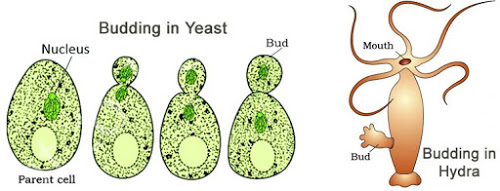
- Buds (‘eyes’) of the potato tuber.
- Rhizomes of banana & ginger.
- Adventitious buds of Bryophyllum. They arise from the notches at margins of leaves.
- Bulbil of Agave.
- Offset of water hyacinth.
- Runner, sucker, tuber, bulb etc.
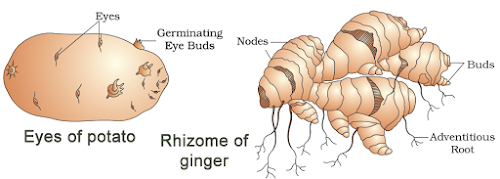
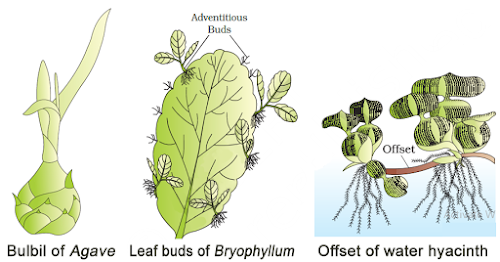
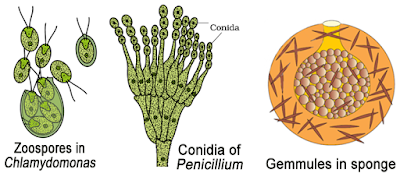
- It is the reproduction that involves formation of male and female gametes, either by the same individual or by different individuals of the opposite sex.
- It results in offspring that are not identical to the parents or amongst themselves.
- It is an elaborate, complex and slow process as compared to asexual reproduction.
- The period of growth to reach in maturity for sexual reproduction is called the juvenile phase. In plants, it is known as vegetative phase.
- In higher plants, the flowering indicates the end of vegetative phase (beginning of reproductive phase).
- Annual & biennial plants show clear cut vegetative, reproductive & senescent phases. In perennial plants, these phases are very difficult to identify.
- Some plants exhibit unusual flowering. E.g.
- Bamboo species flower only once in their lifetime (after 50-100 years), produce large number of fruits and die.
- Strobilanthus kunthiana flowers once in 12 years.
- In animals, juvenile phase is followed by morphological & physiological changes prior to reproductive behaviour.
- Birds living in nature lay eggs only seasonally. However, birds in captivity (e.g. poultry) can be made to lay eggs throughout the year.
- The females of placental mammals exhibit cyclical changes in the ovaries, accessory ducts and hormones during the reproductive phase. It is called oestrus cycle in non-primates (cows, sheep, rat, deer, dog, tiger etc.) and menstrual cycle in primates (monkeys, apes & humans).
- Based on breeding season, mammals are 2 types:
- It is the last phase of lifespan and end of reproductive phase.
- During this, concomitant changes occur in the body. E.g. slowing of metabolism etc. It ultimately leads to death.
- In plants & animals, hormones cause transition between juvenile, reproductive & senescence phases. Interaction between hormones and environmental factors regulate the reproductive processes and the associated behavioural expressions of organisms.
Name of organism | Chromosome number | |
In meiocytes (2n) | In gametes (n) | |
Human being | 46 | 23 |
Housefly | 12 | 6 |
Rat | 42 | 21 |
Dog | 78 | 39 |
Cat | 38 | 19 |
Fruit fly | 8 | 4 |
Ophioglossum | 1260 | 630 |
Apple | 34 | 17 |
Rice | 24 | 12 |
Maize | 20 | 10 |
Potato | 48 | 24 |
Butterfly | 380 | 190 |
Onion | 16 | 8 |
- Male gametes need a medium to move towards female gametes for fertilisation.
- In most organisms, male gamete is motile and the female gamete is stationary. In some fungi and algae, both types of gametes are motile.
- In simple plants (algae, bryophytes & pteridophytes), gamete transfer takes place through water medium. To compensate the loss of male gametes during transport, large number of male gametes is produced.
- In seed plants, pollen grains (in anthers) carry male gametes and ovule carries the egg. Pollen grains are transferred to the stigma.
- In bisexual self-fertilizing plants (e.g. peas), anthers & stigma are closely located for easy transfer of pollen grains.
- In cross pollinating plants (including dioecious plants), pollination helps in transfer of pollen grains. Pollen grains germinate on the stigma and the pollen tubes carrying the male gametes reach the ovule and discharge male gametes near the egg.
- In dioecious animals, the fertilisation helps for successful transfer and coming together of gametes.
- It is the fusion of gametes to form a diploid zygote.
- In rotifers, honeybees, some lizards, birds (turkey) etc., female gamete develops to new organisms without fertilisation. This is called parthenogenesis.
- Development of the zygote depends on the type of life cycle of the organism and the nature of environment.
- In fungi and algae, zygote develops a thick wall that is resistant to desiccation and damage. It undergoes a period of rest before germination.
- In organisms with haplontic life cycle, zygote divides by meiosis into haploid spores that grow into haploid individuals.
- Sexually reproducing organisms begin life as a zygote.
- Zygote is the vital link between organisms of one generation and the next.
- It is the development of embryo from the zygote.
- During embryogenesis, zygote undergoes cell division (mitosis) and cell differentiation.
- Cell divisions increase the number of cells in the embryo. Cell differentiation causes the modifications of groups of cells into various tissues and organs to form an organism.
- Based on place of zygote development, animals are 2 types:
CBSE Class 12th Biology Notes: Reproduction in Organisms
Find CBSE Class 12th Biology notes for the chapter Reproduction in Organisms. Every concept is followed by the solved and unsolved questions. You can also find the various categories questions like short, very short and long answer type
Find CBSE Class 12th Biology notes for the chapter Reproduction in Organisms. Every concept is followed by the solved and unsolved questions. You can also find the various categories questions like short, very short and long answer type.
Some important terminologies and concepts are given below:
Reproduction-As a biological process in which an organisms gives rise to young ones similar to itself.
Clone-Morphologically and genetically similar individuals is called clone.
Binary Fission-Many single celled organisms reproduce by binary fission, where a cell divides in two halves and each rapidly -grows into adult.
e.g. Amoeba, Paramecium and yeast.
Vegetative Propagation-In plant the formation of vegetative propagation does not evolve two parent, the process Involved in a sexual so is called vegetative propagation.
Monoceious – Homothelics like cucurbits, Bisexual Coconut, Chara.
Dioecious – Heterothelic and Unisexual Papaya, date Palm, marchantia.
Parthenogenesis – When the female gamete undergoes development to form new organisms without fertilization, This Phenomenon is called parthenogenesis e.g. Rotifers, honeybees, lizards and birds (turkey).
Gametogenesis – The process of formation of the two type of gametes male and female. The male gamete is called the aniherozoid or sperm; and female gamete is called egg or ovum.
Spermatogenesis – lt is the process of formation of haploid spermatozoa from diploid male germ cells of the testes.
A spermatogonium produces four spermatozoa (sperms).
Oogenesis – It is the process of formation of haploid ova from the gamete’ mother cells (oogania) in the ovany. An oogonium form only one ovum.
Lets discuss some unanswered questions from this chapter
Q1.Explain – in asexual reproduction a part of organism separates and forms a new organism?
Q2.Name the parasite which causes black fever
Q3 .How does reproduction take place by multiple fission?
Q4. What do you understand by the term daughter nuclei?
Q5.Colonies of yeast do not multiply in water but they do multiply in sugar solution. explain
Q6.How does bread mould formation takes place
Q7.Regeneration and its function. Why complex organisms cannot reproduce though regeneration?
Lets discuss 2 marks long answer questions from this chapter
Q. 1. Draw a labelled diagram of conidia of penicillium.
Ans.
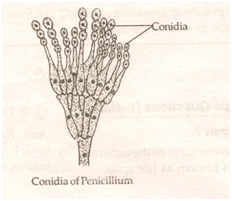
Q. 2. Diagrammatically represent the asexual reproduction in yeast.
Ans.

Q. 3. What is fission ? Name the type of fission.
Ans. Fission : It is a type of sexual reproduction in which a fully grown parental organism divides into two or more than two daughters.
It is of two types.
(i) Binary fission
(ii) Multiple fission
Q. 4. Diagrammatically represent the asexual reproduction in Amoeba ?
Ans.
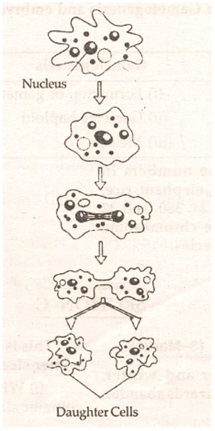
Q. 5. Write the two significance of vegetative propagation ?
Ans. (i) Characters of the parents plants are preserved. A good variety produced can be propagated by vegetative propagation?
(ii) It is easier and cheaper method of propagation.
Q. 6. When artificial methods of vegetative propagation are utilised ?
Ans (i) For quick production of new plants.
(ii) For combining good qualities of two different varieties.
Q. 7. Write the Zoological name of given animals.
Rhesus monkey, Goat, Guinea, Pig, Ascaris.
Ans.
| Animals | Zoological Name |
(i) Rhesus monkey. (iii) Guinea Pig (iv) Ascaris | Maccaca Mulatto Copra hircus Cavia cubaya Ascaris megaloce phala |
Q. 8. Identify each part and write whether it is haploid (n) or diploid (2n) Ovary, Anther, Egg, Pollen, male gamete and Zygote.
Ans.
(a) Ovary – Diploid (2n)
(b) Anther – Diploid (2n)
(C) Egg – Haploid (n)
(d) Pollen -Haploid (n)
(e) Male gamete – Haploid (n)
(f) Zygote – Diploid (2n)
Q. 9. If the Chromosome numbers in meiocytes of human beings, rat, elephant, rice, butterfly and onion. 46, 42, 56, 24, 380, and 32 respectively. What will be the chromosome number in gametes of these species.
Rat = 21
Elephant = 28
Rice = 12
Butterfly = 190
Onion = 16.
Ans. Human beings = 23
Lets discuss 3 marks answer questions from this chapter
Q. 1. In extreme summer and winter, certain animals like frogs and hazards abandon active life.
This is popularly called summer sleep and winter sleep respectively.
(i) What are the technical terms for summer sleep and winter sleep?
(ii) State any two changes in the body that occur during the above mentioned dormant stale.
Ans. Technical terms are as follows :
Winter sleep – Hibernation
Summer sleep — Aestivation
(i) Rate of metabolism declines
(ii) Respiration takes place through skin only (Cutaneous respiration).
Q. 2 Show by a series of diagrams the manner of regeneration in a hydra if it is cut into two pieces transversely at the, middle.
Or
Show by a series of diagrams the manner of transverse binary fission in Planaria.
Ans.
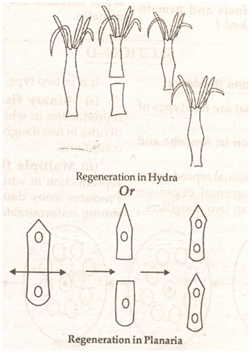
Q. 3. What is vegetative propagation? Give two suitable examples.
Ans. Vegetative propagation in plants is a, type of asexual reproduction in which new individual appears from any vegetative parts of parents plant.
In plants, The units of vegetative propagation such as runner, rhizome, sucker, tuber, offset, bulb are all capable of giving rise to new offsprings.
Such structures are called vegetative propagules.
Examples of vegetative propagation are:
(i) Vegetative propagation by leaves, in Bryophyllum.
(ii) Vegetative propagation by Stem (rhizome) in Ginger, Turmeric etc.
Q. 4. Define the following terms:
(i) Juvenile Phase,
(ii) Reproductive Phrase
(iii) Senescent Phase
Ans. (i) Juvenile Phase- The period of growth and maturity in life when then organisms reproduce sexually. This period of growth is called Juvenil Phase, or Vegetative phase.
(ii) Reproductive Phase-The end of Juvenile Phase is indicated by many of them showing morphological and physiological changes prior to active reproductive behaviour,
(iii) Senscent Phase-The end of reproductive phase is one of the parameters of senescene or old stage. At this stage body metabolism is shown down and ultimately this stage leads to death.
Q. 5. Explain why meiosis and gamete genesis are always Inter linked ?
Ans. Gametogenesis refers to the process of formation of two types of gametes male and female. Gametes are haploid cells. Gametes in all heterogametic species are of two types i.e., male and female. A haploid parent produced gametes by mitosis.
But in majority of organisms, Parent body is diploid. Thus meiosis is required by such diploid. Organisms, to produce haploid gametes. In haploid organisms meiocytes undergo meiosis. At the end of meiosis only one set of chromosome is incorporated into each gametes.
Let’s discuss 5 marks long answer questions from this chapter
Also Read: CBSE Class 12th Solved Question Papers PCB – eBook
Q. 1. Define fission, what are two types of fusion?
Describe multiple .fission irt Amoeba and Binary fission.
Ans. Fission is a type of sexual reproduction in which a fully grown parental organism divides into two or more than two daughters. It is of two type.
(i) Binary fission-A type of asexual reproduction in which the Parental Organisms divides in two daughters cells during favourable conditions.
(ii) Multiple fission-A type of sexual reproduction in which the Parental Organisms Produces many daughter cells simultaneously during unfavourable conditions.
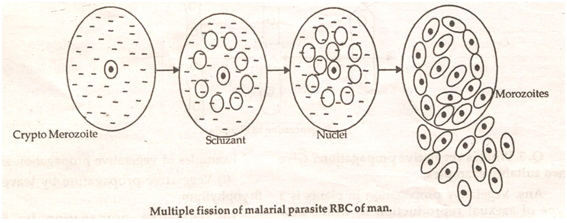
Q. 2. The- unicellular organisms which reproduce by binary fission are causidered immortal Instify.
Ans. Asexual reproduction is common among single-celled organisms. Thus in these organisms cell division is itself a mode of reproduction. In binary fission. The parent body divides into two halves and each rapidly growing into an adult. There is no remains of parents body cell and parent cannot be said to have dead. In fact after binary fission, parent continues living as two daughter- individuals. Hence, the unicellular organisms which undergo binary fission are considered immortal. Example-Amoeba and Paramecium.
There are some small and I marks questions based on this chapter
Q. 1. What is life Span ?
Ans. The period between birth to the natural death of an organisms is known as life span.
Q. 2. Define reproduction.
Ans. Reproduction is a biological process by which an organisms produces another organisms of its own kind.
Q. 3. Name two monoecious plants.
Ans. Cucurbita and Coconuts.
Q.4. Name two dioecious plants.
Ans. Papaya and date palm.
Q. 5. Name one bisexual and one unisexual animal.
Ans. Bisexual – Earthworm. Unisexual – Cockroach.
Q. 6. What are post-fertilisation events?
Ans. The post-fertilisation events included:
1. Formation of diploid zygote.
2. Development of embryo from zygote by the process called embryogenesis.
Q. 7. “Amoeba is immortal”. Explain.
Ans. Amoeba is considered immortal because it does not undergo natural death.
Q. 8. Which is the most critical event in Sexual Reproduction.
Ans. Fertilisation of gametes is the most critical event in Sexual Reproduction.
Q. 9. Give two example which reproduce a sexually by binary fission.
Ans. Bacteria and Amoeba reproduce by binary fission.
Q. 10. What are the Vegetative Propagules.
Ans. In plants, the units of vegetative propagation, such as tuber, bulb, rhizome etc. are called vegetive propagules.
Q. 11. Why offsprings of Oviperous animals are at a greater risk as compared to offsprings of viviparous animals.
Ans. Oviparous animals lay eggs in a safe place in the environment. In an open area, the eggs are not always safe and the offsprings are always at a risk.
Q. 12. How many type of natural vegetative reproduction take place in flowering plants?
Ans. The natural vegetative reproduction takes place by modified tuberous roots having adventitious buds, under ground modified stems, creeping stems, leaves, balbs and turions.
Q. 13. Name the artificial means of vegetative reproduction.
Ans. The artificial means of vegetative reproduction are cutting, layering, grafting and micropropagation.
Reproduction in Organisms Class 12 Biology MCQs
1. The terms homothallic and monoecious are used to denote
(a) unisexual condition
(b) bisexual condition
(c) staminate flowers
(d) pistillate flowers.
Answer
Answer: b
2. The most significant feature of vegetative propagation is that
(a) it is a method of producing a large number of individuals genetically identical to the parent.
(b) it is a method of producing a large number of individuals genetically different from the parent.
(c) it ensures that the progeny individuals are resistant to diseases and pests.
(d) it is an age old practice.
Answer
Answer: a
3. In animals, juvenile phase is followed by,
(a) reproductive phase
(b) senescent phase
(c) old age
(d) vegetative phase.
Answer
Answer: a
4. External fertilisation occurs in majority of
(a) fungi
(b) liverworts
(c) algae
(d) mosses
Answer
Answer: c
5. Vegetative propagation in Pistia occurs by
(a) sucker
(b) offset
(c) runner
(d) rhizome
Answer
Answer: b
6. Sugarcane is propagated by
(a) stem cutting
(b) leaf buds
(c) root cutting
(d) seeds
Answer
Answer: a
7. A multicellular, filamentous alga exhibits a type of sexual life cycle in which the meiotic division occurs after the formation of zygote. The adult filament of this alga has [NCERT Exemplar]
(a) haploid vegetative cells and diploid gametangia
(b) diploid vegetative cells and diploid gametangia
(c) diploid vegetative cells and haploid gametangia
(d) haploid vegetative cells and haploid gametangia
Answer
Answer: d
8. Offspring formed by sexual reproduction exhibit more variation than those formed by Asexual reproduction because [NCERT Exemplar]
(a) sexual reproduction is a lengthy process
(b) gametes of parents have qualitatively different genetic composition
(c) genetic material comes from parents of two different species
(d) greater amount of DNA is involved in sexual reproduction.
Answer
Answer: b
9. There is no natural death in single celled organisms like Amoeba and bacteria because [NCERT Exemplar]
(a) they cannot reproduce sexually
(b) they reproduce by binary fission
(c) parental body is distributed among the offspring
(d) they are microscopic
Answer
Answer: c
10. There are various types of reproduction. The type of reproduction adopted by an organism depends on [NCERT Exemplar]
(a) the habitat and morphology of the organism
(b) morphology of the organism
(c) morphology and physiology of the organism
(d) the organism’s habitat, physiology, and genetic makeup
Answer
Answer: d
11. Appearance of vegetative propagules from the nodes of plants such as sugarcane and ginger is mainly because [NCERT Exemplar]
(a) nodes are shorter than intemodes
(b) nodes have meristematic cells
(c) nodes are located near the soil
(d) nodes have non-photosynthetic cells
Answer
Answer: b
12. Identify the correct sequence of events.
(a) Gametogenesis → Syngamy Embryogenesis → Zygote
(b) Gametogenesis → Zygote → Syngamy → Embryogenesis
(c) Gametogenesis → Embryogenesis → Zygote → Syngamy
(d) Gametogenesis → Syngamy → Zygote
Answer
Answer: d
13. Development of unfertilised ovum into a new individual is called ____ .
Answer/Explanation
Answer:
Explaination: Parthenogenesis.
14. Earthworms and sponges are _____ animals.
Answer/Explanation
Answer:
Explaination: Bisexual/Hermaphrodite.
15. Gametogenesis and gamete transfer are _____ events.
Answer/Explanation
Answer:
Explaination: Pre-fertilisation.
16. ____ cycle occurs in non-primate mammals like cows and dogs.
Answer/Explanation
Answer:
Explaination: Oestrous.
17. _____ are the motile microscopic structures produced by many algal species.
Answer/Explanation
Answer:
Explaination: Zoospores.
18. Vegetative reproduction in plants is a method of _____ reproduction.
Answer/Explanation
Answer:
Explaination: Asexual.
19. ____ results in the formation of zygote.
Answer/Explanation
Answer:
Explaination: Syngamy.
20. In oviparous animals like reptiles and birds, the fertilised egg is covered by a _____ shell and laid in a safe place.
Answer/Explanation
Answer:
Explaination: Calcareous.
21. _____ is the vital link that ensures continuity between one generation to the next.
Answer/Explanation
Answer:
Explaination: Zygote.
22. The offspring of ____ animals are vulnerable to predators.
Answer/Explanation
Answer:
Explaination: Oviparous.
23. Match the asexual reproductive structures in Column I with the organisms in Column II.
| Column I | Column II |
| A. Conidia | 1. Chiamydomonas |
| B. Gemmules | 2. Hydra |
| C. Zoospores | 3. Penicillium |
| D. Buds | 4. Sponges |
| 5. Banana |
Answer/Explanation
Answer:
Explaination: A – 3, B – 4, C – 1, D – 2
24. Match the terms in Column I with the organisms in Column II.
| Column I | Column II |
| A. Fragmentation | 1. Pistia |
| B. Binary fission | 2. Spirogyra |
| C. Bulbils | 3. Saccharomyces |
| D. Budding | 4. Paramoecium |
| 5. Agave |
Answer/Explanation
Answer:
Explaination: A – 2, B – 4, C – 5, D – 3
25. In papaya and date palm, both male and female flowers are present on the same plant. [True/False]
Answer/Explanation
Answer:
Explaination: False.
26. Mitotic cell divisions occur during embryo-genesis. [True/False]
Answer/Explanation
Answer:
Explaination: True.
27. Plants produced through vegetative propagation are called clones. [True/False]
Answer/Explanation
Answer:
Explaination: True.
28. Bony fishes, bryophytes and pteridophytes show internal fertilisation. [True/False]
Answer/Explanation
Answer:
Explaination: False.
29. Gametes are always haploid and gametogenesis always involves meiosis. [True/False]
Answer/Explanation
Answer:
Explaination: False.
Directions (Q30 to Q34): Mark the odd one in each of the following groups.
30. Earthworms, Sponges, Cockroaches, Tapeworms.
Answer/Explanation
Answer:
Explaination: Cockroaches.
31. FUCHS, Cladophora, Funaria, Homo sapiens
Answer/Explanation
Answer:
Explaination: Cladophora.
32. Turkey, Honey bees, Camels, Rotifers
Answer/Explanation
Answer:
Explaination: Camels.
33. Bony fishes, Reptiles, Birds, Bryophytes
Answer/Explanation
Answer:
Explaination: Bony fishes.
34. Reptiles, Monkeys, Birds, Frogs
Answer/Explanation
Answer:
Explaination: Frogs.
35. Name the biological process that enables continuity of species. [Delhi 2012C]
Answer/Explanation
Answer:
Explaination: Reproduction.
36. Define reproduction.
Answer/Explanation
Answer:
Explaination: Reproduction is defined as the biological process, in which an organism gives rise to young ones similar to itself.
37. Name the mode of reproduction that helps in producing genetically identical offspring. [Delhi 2012C]
Answer/Explanation
Answer:
Explaination: Asexual reproduction.
38. Offspring derived by asexual reproduction are called clones. Justify giving two reasons. [AI 2010; HOTS]
Answer/Explanation
Answer:
Explaination: (i) They are genetically and morphologically identical among themselves.
(ii) They are also genetically and morphologically identical to the parent.
39. Name an organism where cell division in itself is a mode of reproduction. [AI 2013; Foreign 2010]
Answer/Explanation
Answer:
Explaination: Amoeba, Paramoecium (any one)
40. Name the type of asexual reproduction, where the parent cell ceases to exist. [Delhi 2017C]
Answer/Explanation
Answer:
Explaination: Binary fission.
41. Which ones of the following organisms exhibit binary fission?
Bacillus, Penicillium, Yeast, Amoeba. [AI 2012C]
Answer/Explanation
Answer:
Explaination: Bacillus and Amoeba
42. Provide an example of each of single-celled organisms, which reproduce by:
(i) binary fission, (ii) budding. [Delhli 2017C]
Answer/Explanation
Answer:
Explaination: (i) Amoeba/Paramoecium
(ii) Yeast.
43. Which of the following statements is true of yeast?
(a) The cell divides by binary fission. One of them develops into a bud.
(b) The cell divides unequally. The smaller cell develops into a bud.
(c) The cell produces conidia, which develop into a bud. [Delhi 2013C]
Answer/Explanation
Answer: b
Explaination: (b) is true of yeast.
44. Name the organism and the mode of reproduction represented in the diagram given below. [AI 2010C]
Answer/Explanation
Answer:
Explaination: – Yeast
– Budding.
45. In yeast and Amoeba, the parent cell divides to give rise to two new individual cells. How does the cell division differ in these two organisms? [Foreign 2010; HOTS]
Answer/Explanation
Answer:
Explaination: – In yeast, the cell division is unequal; the small cell grows into a bud, which remains attached to the large cell in the initial stages, but gets separated later.
– In Amoeba, the cell reproduces by binary fission, where the cell divides into two halves and each one grows rapidly into an adult.
46. Write one difference between binary fission and budding. [Delhi 2017C]
Answer/Explanation
Answer:
Explaination:
47. Under unfavourable conditions, Amoeba shows encystation. What does it mean?
Answer/Explanation
Answer:
Explaination: Under unfavourable conditions, Amoeba withdraws its pseudopodia and develops a three-layered thick wall called cyst around it; this process is called encystation.
48. Give one example each of a fungus, which reproduces by: [AI 2014C]
(a) budding
(b) conidia
Answer/Explanation
Answer:
Explaination: (a) Yeast
(b) Penicillium
49. Name an alga that reproduces asexually through zoospores. Why are these reproductive units so called? [AI 2013]
Answer/Explanation
Answer:
Explaination: Chlamydomonas. The zoospores are motile (like animals).
50. Identify the reproductive structure and name the organism they are being released from. [Delhi 2010C]
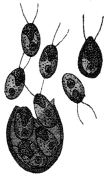
Answer/Explanation
Answer:
Explaination: – Zoospores
– Chlamydomonas
51. Mention a characteristic feature and a function of zoospores in some algae. [AI 2010]
Answer/Explanation
Answer:
Explaination: – Zoospores are microscopic, thin-walled and motile with flagella.
– They are meant for asexual reproduction.
52. How does Penicillium reproduce asexually? [Delhi 2011]
Answer/Explanation
Answer:
Explaination: Penicillium reproduces asexually by forming conidia.
53. Name the respective asexual reproductive structures of Yeast and Sponge. [AI 2012C]
Answer/Explanation
Answer:
Explaination: Yeast – Buds
Sponge – Gemmules
54. Which of the following statements is true of Hydra? [AI 2013C]
(a) It produces asexual gemmules.
(b) It produces unicellular bud.
(c) It produces multicellular bud.
Answer/Explanation
Answer: c
Explaination: (c) is true of Hydra
55. How is the phenomenon regeneration useful to a lizard?
Answer/Explanation
Answer:
Explaination: A lizard can discard a part of its tail, when in danger and it is regenerated later.
56. Name the vegetative propagules in the following: [AI 2014]
(a) Agave
(b) Bryopbyllum
Answer/Explanation
Answer:
Explaination: (a) Bulbils
(b) Leaf buds.
57. Give one example each of a plant that reproduces by
(a) runner
(b) offset
Answer/Explanation
Answer:
Explaination: (a) Grasses
(b) Water hyacinth.
58. Write the name of the organism that is referred to as the ‘Terror of Bengal’ [Delhi 2014]
Answer/Explanation
Answer:
Explaination: Water hyacinth.
59. Identify the picture and mention the vegetative part that helps it to propagate. [AI 2015C]
Answer/Explanation
Answer:
Explaination: – It is rhizome (modified stem) of ginger.
– Rhizome is the vegetative propagule, the buds in it help it to propagate.
60. Identify ‘A’ in the given diagram and state its function [Delhi 2016C]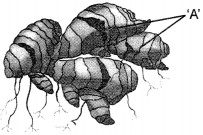
Answer/Explanation
Answer:
Explaination: – ‘A’ shows the nodes of the rhizome of ginger.
– The buds arising from the nodes produce new plants, i.e., vegetative propagation.
61. Which of the following statements is true of ginger? [AI 2013C]
(a) Germinating bud appears from the eye of the stem tuber.
(b) Germinating bud appears from the node of the rhizome.
(c) Germinating bud appears from the notch of the leaf margin.
Answer/Explanation
Answer: b
Explaination: (b) is true of Ginger
62. Why do intemodal segments of sugarcane fail to propagate vegetatively, even when they are in contact with damp soil? [CBSE Sample Paper 2010; HOTS]
Answer/Explanation
Answer:
Explaination: The plantlets arise from the buds present on the nodes; only when the nodes come in contact with the damp soil, will they produce roots and shoots and not from internodal segments.
63. Name the vegetative propagules in [Foreign 2017]
(i) Potato and
(ii) Pistia.
Answer/Explanation
Answer:
Explaination: (i) ‘Eyes’ (buds) in the tuber
(ii) Offset.
64. Name the units of vegetative propagation in grasses and water hyacinth. [AI 2012C]
Answer/Explanation
Answer:
Explaination: Grasses – Runner
Water hyacinth – Offset
65. Identify ‘A’ in the diagram and mention its function. [Delhi 2016 C]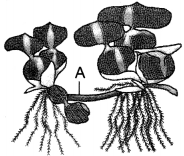
Answer/Explanation
Answer:
Explaination: – ‘A’ is the offset of water hyacinth.
– It is the vegetative propagule that helps it to propagate.
66. Which of the following statements is true of Bryophyllum? [Delhi 2013C]
(a) Germinating bud appears from the eye of the stem tuber.
(b) Germinating bud appears from the node of the rhizome.
(c) Geminating bud appears from the notch at the leaf margin.
Answer/Explanation
Answer: c
Explaination: (c) is true of Bryophyllum.
67. Identify ‘A’ in the diagram and mention its function. [Delhi 2016C]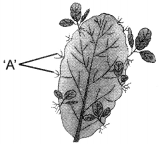
Answer/Explanation
Answer:
Explaination: – ‘A’ represents the leaf buds on a leaf of Bryophyllum.
– The leaf buds produce plantlets when the leaf falls and comes in contact with damp soil.
68. Name the mode of reproduction that ensures the creation of new variants, [Delhi 2012C]
Answer/Explanation
Answer:
Explaination: Sexual reproduction.
69. Name the phase, all organisms have to pass through before they can reproduce sexually. [AI 2011]
Answer/Explanation
Answer:
Explaination: Juvenile phase (vegetative phase in plants)
70. What marks the end of juvenile phase in flowering plants?
Answer/Explanation
Answer:
Explaination: Initiation of floral buds marks the end of juvenile phase in flowering plants.
71. Name the two groups of plants which show clear cut vegetative, reproductive and senescent phases.
Answer/Explanation
Answer:
Explaination: Annual and biennial plants.
72. Mention the unique flowering phenomenon exhibited by Strobilanthus kunthiana (neelakurinji). [Delhi 2012]
Answer/Explanation
Answer:
Explaination: This plant flowers once in twelve years.
73. Mention the unique feature with respect to flowering and fruiting in bamboo species. [Delhi 2012]
Answer/Explanation
Answer:
Explaination: Bamboo flowers only once in its life time, generally after 50-100 years. It produces a large number of fruits and seeds and dies.
74. Name two animals that exhibit oestrous cycle. [Foreign 2016]
Or
Give an example of an animal that exhibits oestrous cycle. [AI 2014C]
Answer/Explanation
Answer:
Explaination: Cows/Sheep/Rats/Dogs/Deers/Tiger.
75. Write the two pre-fertilisation events from the list given below: Syngamy, Gametogenesis, Embryogenesis, Pollination. [Delhi 2014C]
Answer/Explanation
Answer:
Explaination: Gametogenesis and pollination.
76 Which one of the following statements is true of Cucurbits?
(a) It is monoecious producing both staminate and pistillate flowers in the same plant.
(b) It is monoecious producing staminate and pistillate flowers in two different plants.
(c) It is dioecious producing staminate flowers in one plant and pistillate flowers in another. [Delhi 2013C]
Answer/Explanation
Answer: a
Explaination: (a) is true of Cucurbits.
77. Which of the following statements is true of date palm? [AI 2013C]
(a) It is monoecious producing both staminate flowers and pistillate flowers in the same plant.
(b) It is monoecious producing staminate flowers in one tree and pistillate flowers in another tree.
(c) It is dioecious producing staminate flowers in one tree and pistillate flowers in another tree.
Answer/Explanation
Answer: c
Explaination: (c) is true of date palms.
78. Cucurbits and papaya plants bear staminate and pistillate flowers. Mention the categories they are put under separately on the basis of the type of flowers they bear. [Delhi 2012; HOTS]
Or
How are Cucurbita plants different from papaya plants with reference to the flowers they bear? [AI 2011C; HOTS]
Answer/Explanation
Answer:
Explaination: – Cucurbits are monoecious, as staminate and pistillate flowers are found in the same individual plant.
– Papaya plants are dioecious as an individual plant bears exclusively either staminate flowers or pistillate flowers.
79. All papaya plants bear flowers, but fruits are seen only in some. Explain. [AI 2011C; HOTS]
Or
All date palm plants bear flowers, but fruits are seen in some. Explain. [AI 2011C]
Answer/Explanation
Answer:
Explaination: Papaya/date palm is dioecious; the plants which produce only male flowers, do not bear fruits, while the plants which produce female flowers, bear fruits.
80. Label the male and female sex organs writh their technical terms in the figure of Chara, given below.
Answer/Explanation
Answer:
Explaination:
81. Meiosis is an essential event in the sexual cycle of any organism. Give two reasons.? [Foreign 2015; HOTS]
Answer/Explanation
Answer:
Explaination: (i) It creates genetic variation in the offspring and help in survival of species.
(ii) It is necessary to maintain the characteristic chromosome number through generations.
82. Name the group of organisms that produces non-motile male gametes. How do they reach the female gamete for fertilisation? [Foreign 2011]
Answer/Explanation
Answer:
Explaination: – Seed plants (gymnosperms and angiosperms) produce non-motile male gametes.
– They are carried in the pollen tube to the female gametes.
83. Name the phenomenon and one bird where the female gamete directly develops into a new organism. [AI 2013]
Answer/Explanation
Answer:
Explaination: Parthenogenesis is the phenomenon. Turkey shows it.
84. Name the common phenomenon with reference to reproduction in rotifers, honey bees and turkey. [Delhi 2013C]
Answer/Explanation
Answer:
Explaination: They all show parthenogenesis.
85. Name the phenomenon and the cell, responsible for the development of a new individual without fertilisation as seen in honeybees. [Foreign 2011]
Answer/Explanation
Answer:
Explaination: – Parthenogenesis is the phenomenon.
– Female gamete (ovum) is the cell.
86. In the whiptail lizards, only females are bom generation after generation. There are no males. How is this possible? [CBSE Sample Paper 2010; HOTS]
Or
The turkey usually produces females for several generations. How is this possible? [CBSE Sample Paper 2010; HOTS]
Answer/Explanation
Answer:
Explaination: The whiptail lizard/turkey shows parthe-nogenesis, the phenomenon in which the female gamete undergoes development without fertilisation into a new individual; in these animals it develops into a female individual.
87. Mention the site where syngamy occurs in amphibians and reptiles, respectively. [AI 2010]
Answer/Explanation
Answer:
Explaination: – In amphibians, it occurs in the medium of water, i.e. external fertilisation.
– In reptiles, it occurs inside the body of female animals, i.e. internal fertilisation.
88. In which two of the following organisms is fertilisation external?
Bony fishes, Ferns, Frogs, Birds [Delhi 2014C]
Answer/Explanation
Answer:
Explaination: Bony fishes and frogs.
89. Name the type of cell division that takes place in the zygote of an organism exhibiting haplontic life cycle. [Delhi 2011]
Answer/Explanation
Answer:
Explaination: Meiosis.
90. At what stage does meiosis occur in an organism exhibiting haploidic life cycle and mention the fate of the products thus produced. [Delhi 2019]
Answer/Explanation
Answer:
Explaination: – Meiosis occurs during the germination of zygote.
– The haploid spores formed develop into haploid individuals.

